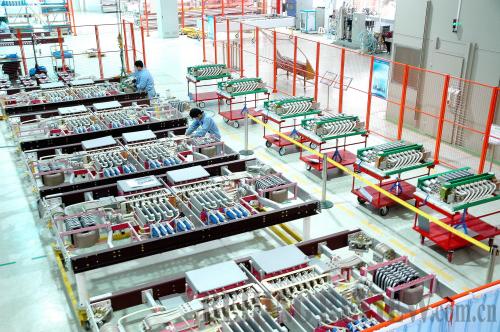|
 |
|
POWERING GROWTH WITH SCIENCE: A workshop in XJ Group Corp., a leading power equipment manufacturer in China (XINHUA) |
Even today some people still think research institutes should play a major role in innovation. Wan said that on one hand, these people worry that Chinese firms are still too weak in innovative ability to play a key role; on the other hand, they do not have thorough understanding of the basic laws of technological innovation.
In fact, the National Medium- and Long-Term Program for Science and Technology Development (2006-20), published in 2005, called for the construction of an enterprise-centered technological innovation system that combines joint efforts of enterprises, universities and research institutes.
In April 2006, the State-Owned Assets Supervision and Administration Council made technological innovative capacity and research and development spending key criteria in evaluating the performance of executives of state-owned enterprises.
In a market economy, enterprises best understand market needs, said Wan, speaking from his own experience in working at Audi Germany.
"Enterprises can become big and strong only by adapting to market changes, while firms' own development requirements are the source of technological innovation," Wan said.
Many firms have realized the importance of innovation during competition. Recently, Wan visited Gree Electric Appliances, Inc. in Zhuhai, Guangdong Province, whose air conditioner sales have led the world for six consecutive years.
Wan said an air conditioner at his home was produced by the company. "After many years of use, nothing has gone wrong with it," he said.
In Gree's technology research institute, there is a special laboratory in which various weather conditions can be simulated for air conditioners to be exposed to, such as thunderstorms.
This year, Gree won the National Science and Technology Progress Award for researching and commercializing the one-hertz variable frequency air conditioner. Gree is the first air conditioner manufacturer to win this honor, thanks to its growing scientific and technological spending. Last year, its research and development spending was 3 billion yuan ($476 million), the highest in China's household electric appliance industry.
"We never cap our research and development spending, and the secret of our success is core technology," said Dong Mingzhu, CEO of Gree.
"Without scientific and technological innovation, a company can only perish," she added. The saleswoman-turned-business-leader was ranked seventh among this year's top 50 women in world business rated by U.K.-based Financial Times.
A growing number of Chinese entrepreneurs are generously investing in research and development. Last year, 74 percent of such investments were made by enterprises, according to data from the Ministry of Science and Technology.
Meanwhile, the allocation structure of government funds has also changed significantly. More and more key national projects in science and technology have been granted to enterprises.
The financial market also plays an increasing role in supporting research and development. The recent high-level conference on innovation also stressed the integration between science and technology and the financial market.
Currently, 52 percent of the 212 Beijing-based A-share listed companies are in the field of science and technology.
In addition, some local governments of Jiangsu, Shanghai and Guangdong have given tax incentives and other preferential treatment to encourage companies to invest in research and development.
In Shenzhen, enterprises begin to play a dominant role in research and development. Data from the Ministry of Science and Technology shows 90 percent of research and development expenditure was paid by enterprises, and 90 percent of the patents were granted to flagship enterprises in 2009.
Despite the progress, scientific and technological reform should be further deepened, as the 2011 National Innovation Index released by the Chinese Academy of Science and Technology for Development showed that the indigenous innovative capacity and core technology ownership of Chinese firms were still not high.
System reform
The current round of reform will focus on improving indigenous innovative capacity, promoting integration of science and technology with economic and social development, and addressing salient issues impeding scientific and technological innovation, said Wan.
| 